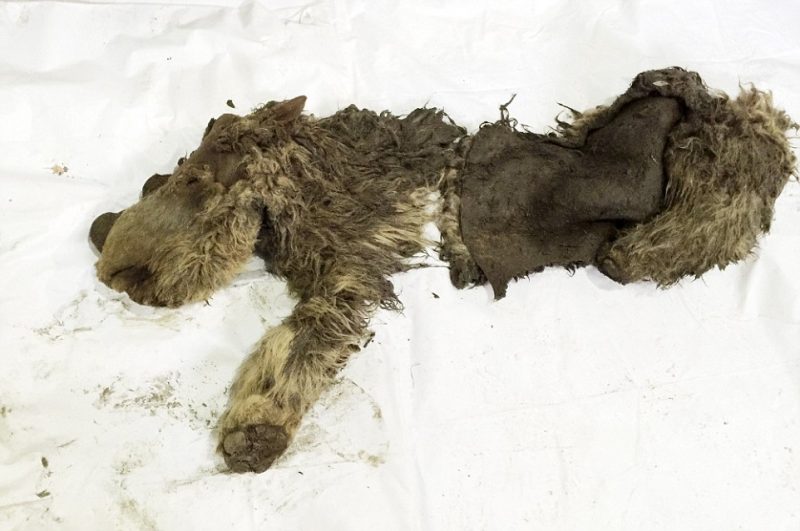In September of 2014, an almost perfectly preserved woolly rhinoceros calf was found in the far north of Siberia last year. It was found by a local hunter, who had initially thought that the remains belonged to a reindeer.
The calf, which was about 18 months old at the time of death, is not only the only infant woolly rhino ever found, but it is also more than three times older than scientists had first believed. In honor of the hunter who uncovered the remains, Alexander Banderov, the calf has been named Sasha. The sex of the calf, by the way, has not been determined, but the name “Sasha” works well for both sexes.
The location where the calf was found was the Abyysky district of the Sakha Republic — also known as Yakutia. It is the largest region of the Russian Federation and is better known for having the remains of woolly mammoths.
When scientists first were notified of Sasha’s discovery, they believed that the calf dated back 10,000 years, but now, after an autopsy was performed, they announced that Sasha actually lived 34,000 years ago. The region in which Sasha lived, they added, was considerably warmer during that time than it is today.
So, what does the phrase “almost perfectly preserved” mean? To be precise, Sasha was recovered with both front and rear legs intact, as well as almost its entire skin. Remnants of two horns were also found on the ancient rhino carcass. Dr. Albert Protopopov, head of the Department of Mammoth Fauna Studies, described the calf to The Siberian Times. “The hair is light grey,” he said. “The head is in good condition—with the ears, eyes, and tongue all preserved.”
To say that scientists around the world are excited would be an understatement — the find is so incredible that Russian scientists are even permitting Western experts to join the research. Specialists from the University of California in Santa Cruz, for example, has been given the key task of analyzing Sasha’s DNA. On top of that, academics from the universities of Bristol and Leeds will also examine the calf, including the DNA of tiny fragments of food found in its teeth.
The Siberian Times reported that the leading Russian scientists believe Sasha probably died by drowning. Dr. Albert Protopopov said, “The nasal passages of the rhinoceros were clogged with mud, so that we can say that most likely it drowned.” He continued, “The DNA of the woolly rhino is poorly studied indeed. This find gives us the opportunity to compare the woolly rhino with the modern rhinos and find out how far they are from each other on the evolutionary path.”
Woolly rhinoceroses are an extinct species of rhinoceros that was once common throughout Europe — reaching as far as Scotland and Spain and northern Asia, including South Korea — during the Pleistocene epoch and survived the last glacial period. The last of the species is thought to have died out around 10,000 years ago.
The species was well adapted to survive its environment. These rhinos had stocky limbs and thick woolly fleece that kept it well insulated in the icy tundra. Based on recovered skeletons and even cave paintings, scientists have estimated that adult woolly rhinos could have reached up to thirteen feet (four meters) long and weighed as much as 4,400 pounds (2,000 kilograms). The two horns located on the skull of the rhino were made of keratin, the larger of the two being about twenty-four inches (sixty-one centimeters) long. Much like the rhinos today, the woolly rhinoceroses used their horns for defensive purposes and as a means to attract mates. Overall, however, these giant animals spent their time grazes on grasses. From previous studies that used DNA, scientists discovered that the closest modern relative of the woolly rhino is the critically endangered Sumatran rhino.
What exactly pushed the woolly rhinoceros to extinction is not known. Researchers do know that the last of the species died out approximately 10,000 years ago. There have been theories, however. Like the woolly mammoth, these animals might have been over-hunted by early man or have been unable to adapt to the receding Ice Age and the subsequent spread of disease, it might have even been a combination of both theories.
At the time of Sasha’s discovery, Dr. Protopopov said, “The find is absolutely unique. We can count a number of adult woolly rhinos found around the world on fingers of one hand.” He explained, “A baby rhino was never found before. There was only one case in the 21st century when we found a frozen carcass of a grown-up woolly rhino in Yakutia. It was in 2007 in Kolyma. In the 20th century, there were carcasses of woolly mammoths found in Verkhoyansky and Vilyuisky districts, but they were mummified and therefore not usable for studies.”
Image credit: Yakutian Academy of Sciences
